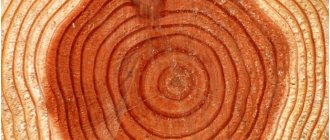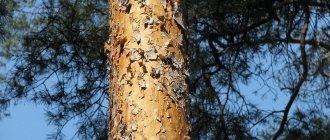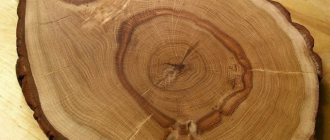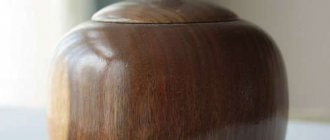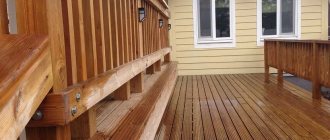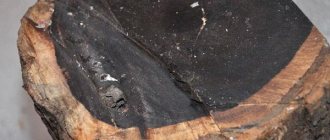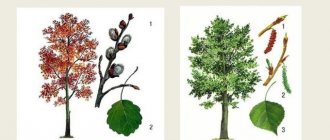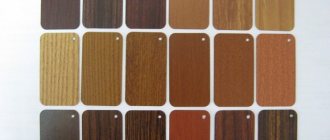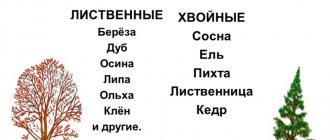An elementary school student knows that the age of woody plants can be determined by cutting them, determining the number of growth rings. This method was first proposed by Leonardo da Vinci. He also suggested the reason on which the width of the rings depends, pointing to meteorological conditions. Russian scientists A.N. Beketov and F.N. Shvedov confirmed his assumptions with their scientific research. But this happened already in the 19th century. And American researchers connected the features of the pattern on the cut and anomalous natural phenomena by comparing the age of plants and the meteorological chronicle in western North America. It turned out that trees that begin their life in the spring have a pattern of growth rings that is noticeably different from those that began in the fall. It is generally accepted that each ring corresponds to one year of life. But in the process of research, scientists found that some trees have false growth rings, while others do not have them at all.
Trees and life
Life on our planet was formed and exists due to many factors, and one of them is the suitable gas composition of the atmosphere. Or rather, the presence of a sufficient amount of oxygen. They are provided to us by plants that absorb carbon dioxide exhaled by most living beings. Currently, most developed and civilized countries strictly monitor the condition of their forests, including creating national parks where very old trees can be found. They are interesting not only from an aesthetic point of view, but also because by studying them, scientists gain knowledge about long-past times, and the age of trees is determined using tree rings. But what is an annual ring, why is it formed, and where is it located besides trees? This is what we will look into in this article.
Dendrochronology
Dendrochronology is a scientific discipline that deals with dating events, natural phenomena and archaeological finds based on studies of tree rings or other biological remains that have them.
For example, this method is most often used to determine the age of some objects or buildings made of wood by tree rings.
We figured out what kind of science it is and what it does. Now let's look at how tree rings are formed.
As we already know, they appear in those trees that grow in areas with pronounced seasonality. Simply put, they grow differently in summer and winter due to temperature changes and other conditions. This leads to the fact that the layer of wood that grows in winter differs from the summer layer in a host of characteristics: color, density, texture, etc. If we talk about visual manifestation, then on the transverse cut of a tree trunk you can see a clear structure in the form of concentric rings.
The history of one of the oldest fortresses in Russia
Now that dendrochronologists have the brightest mark on the tree rings, discoveries began to pour in one after another. In particular, thanks to the “Miyake event,” employees of the Faculty of Geography of Moscow State University were able to determine the exact age of the adobe fortress of Por-Bazhyn in the Republic of Tyva and even establish its purpose. These ancient ruins on the island of Tere-Khol have long excited scientists with their pristineness: during excavations it was obvious that the unusual fortress was not used at all after construction was completed. But why?
For radiocarbon analysis, the researchers took cuts from three larch trunks that were walled up at the base of the adobe walls of Por-Bazhyn. In the third cut ring from the bark they found the “Miyake event.” Further study of the youngest ring at the cellular level allowed scientists to determine that the tree was cut down in the summer. So it became clear that the construction of the fortress began in the summer of 777. Then all that remained was to add historical subtext to this fact, and the “biography” of the building became completely clear.
“In 779 there was an anti-Manichaean coup, during which the ruler was killed. Based on the complex of data, it was suggested that the purpose of the complex was not defensive, as previously thought, but cultic: it was a Manichaean monastery. If the monastery was built on the eve of the coup, then the previous rulers simply did not have time to use it, and the new ones no longer needed it - this explains the main mystery of Por-Bazhyn, the absence of traces of its use,” summed up the professor of the Faculty of Geography of Moscow State University, deputy director of the Institute of Geography of the Russian Academy of Sciences Andrei Panin.
Where is the tree's memory?
Trees have a “memory”, and it is much stronger than human memory. And since green giants live for several hundred and even thousands of years, they can be considered a real storehouse of information. Everyone has seen the growth rings on the cut of a trunk - this is a secret writing in which the history of the entire life of a tree is encrypted, and an initiate can read it.
Most of the tree trunk is made up of cells devoid of living contents, essentially just tubes of wood through which water moves from the roots to the leaves. Living cells are concentrated mainly between wood and bark. This layer, the cambium, ensures the tree grows in thickness, as well as the growth of the bark layer.
In woody plants of temperate latitudes, periodicity is observed in the activity of the cambium. Thus, in spring and early summer, cambium cells rapidly divide, and during this period, the so-called early wood is formed. Its cells are characterized by large cavities and thin cell walls, which facilitate the transport of water through the tissues of the tree. At the end of summer, the activity of cell division in the cambium decreases. And the cells that form during this period are morphologically different from those that are formed at the beginning of summer - they have small diameters and thick cell walls, their main function is to ensure the strength of the trunk. In places experiencing strong mechanical stress, such cells are formed from the very beginning of the growing season, resulting in the creation of so-called lurch wood.
The phenomena we described are primarily characteristic of coniferous species. Those who carefully examined a fresh pine or spruce stump probably noticed light concentric stripes - early wood, dark concentric stripes - late wood, and perhaps also observed dark spots of lurch wood. Other species, such as oak or birch, have their own specific characteristics in the structure of their growth rings.
Tree rings are zones of cyclical tissue growth in trees, caused by uneven development under the influence of external factors.
Ecology DIRECTORY
Oak wood should be considered as an example of ring-vascular type hardwood. In wood of this type there are very large vessels, visible to the naked eye, which are located in one, two, three rows in the early part of each annual layer, in a ring along its border (Fig. 20). Oak belongs to the type of sound tree species. Its wood is divided into a peripheral part, which is lighter, called sapwood, and a central, dark part, which includes the bulk of the annual layers, called heartwood. In this older wood, as a rule, there are no living cells left; their living contents with reserve substances gradually, during the formation of heartwood, turn into substances of a protective nature - tannins, pigments and others, and the vessels are overgrown with outgrowths of neighboring living cells - tillami , as a result of which they stop conducting water. The birch wood discussed earlier does not have typical heartwood; aging phenomena are much less pronounced in it. Birch belongs to the sapwood species.[...]
Tree rings are zones of wood growth in plants or mineralized formations in animals that arise in connection with seasonal changes in the rate of tissue growth. Dimensions G.k. depend on the characteristics of the environment in a particular year. G.k. are used to determine the age structure of populations, analyze the growth rates of individual individuals, and other calculations. See also Dendrochronology.[...]
The wood is dense, with clear annual rings (with the exception of Engelhardia and South American walnut species).[...]
The wood of the capitate thyssaceae does not have a clear division into heartwood and sapwood; it is yellowish or brownish-white. In trees growing in subtropical regions the growth rings are poorly visible, but when grown north of the edge of their native range they are often more or less distinct. There are no resin channels in wood, sometimes only in the core. Wood parenchyma is mostly diffuse. Tracheids have from 1 to 3 spiral thickenings. On a radial section in the tracheids of early wood, the bordered pores are predominantly single-row, round, the entrance to the bordered pore is slit-like, sometimes cross-shaped, in the tracheids of late wood both openings are slit-like. Radial rays without ray tracheids, mostly uniseriate.[...]
The tree ring consists of early, or spring, wood (with thin-walled, light-colored tracheids) and late, or summer, wood (with thick-walled, dark-colored tracheids). Due to the weakening of the ascending water current in the deeper annual layers of the trunk, living cells die and all parts of the ring become tarred. [...]
Tree rings grow each growing season as a result of the periodic activity of the cambium and consist of two parts: early wood (lighter, deposited in the first half of the growing season) and late wood (darker, deposited in the second half of the growing season). Early wood has more water-conducting elements, while late wood has more mechanical elements. Tree rings are clearly visible in coniferous and deciduous ring-vascular species (oak, ash, etc.). In scattered vascular trees (birch, aspen) they are poorly visible. The laying of various annual wood rings is typical for zones with well-defined seasons. In the humid tropics, where winter and summer are almost the same in terms of precipitation and temperatures, there are no noticeable tree rings.[...]
The appearance of tree rings depends on the plane in which they are viewed (Fig. 2). At the end of the log they look like concentric circles located around the core. During the year, only one layer grows, called the annual layer. The patterns on the surface of the boards obtained from the growth rings depend on the planes on which they are visible. On the radial surface of wood, growth rings look like parallel lines (Fig. 2, b). On the tangential surface (in the plane tangent to the annual layers), concentric and parabolic curves are usually visible. This is explained by the nature of secondary thickening in trees, due to which the cut plane intersects several growth rings. Each individual ring of growth does not appear to the same extent in the wood, because the intensity of growth, and therefore the density of the resulting wood, is not the same throughout the growing season. Typically, the most rapid increase in thickness occurs at the beginning of the growing season and slows down noticeably towards the end. The part of the ring that forms in the spring, when growth resumes, is intended primarily for the movement of sap, so it is more porous and often has a low density. This tissue is called early, or spring, wood. Wood produced in the second half of the growing season is called late or summer wood. It is usually denser and darker than the early one. This can be seen when viewing it at low magnification or even with the naked eye. Summer wood is well adapted to provide trunk strength and, in all likelihood, does not participate in the transfer of sap to the same extent as spring wood. The difference between the denser and darker summer wood of a given growth and the looser and lighter spring wood of the subsequent zone makes it possible to distinguish between growth rings.[...]
Porous types of wood, in turn, are divided into two classes. In some deciduous trees, the vessels in the spring wood are much larger than the vessels located in the outer (autumn) zone of the growth ring, and the transition from one zone to another is more or less abrupt. These types of wood are called ring-pore wood; these include, for example, oak, elm, and ash. In open-pore wood species (maple, birch and American linden), the pore size changes little throughout the entire annual ring.[...]
The width of the annual layer changes by changing both its early and late zones. Until recently, it was believed that the absolute value of late wood in layers of different widths remains unchanged, and the change in the width of the entire layer occurs only at the expense of the early part. Only recently, in relation to pine (40), spruce (4) and larch (42), it was established that the width of the late zone can increase with increasing width of the annual layer. In confirmation of this, N.I. Strekalovsky (and) in relation to pine from the river basin. Vagi came to the conclusion that the relationship between the width of the entire annual ring and the width of its late zone is expressed by a second-order parabola.[...]
With an increase in the width of the annual layer, after thinning in oak stands of 27-84 years of age, the sizes of wood fibers, tracheids and vascular cells increase. The ratio between the spring and summer parts of the annual ring becomes most favorable. The share of summer thick-walled oak wood reaches 70% due to the reduction of the thin-walled spring part (Savina).[...]
The degree of necrotization of wood depends on the size of the infection: when the fungus penetrates one root, necrotization occurs of a small part of the annual ring, and when it penetrates several roots, the entire ring occurs.[...]
Line 1-I, separating the growth rings, stands out because the fibrous cells, as they approach the outer edge, become somewhat flattened tangentially. In the subsequent ring behind them there are cells of a much larger diameter, and the differences in shape in the cross section make it possible to delimit the limits of the two rings when the wood is viewed across the grain at sufficiently high magnifications. [...]
However, the increase in late wood with the expansion of the annual ring is not unlimited, and there is no reason to expect an improvement in wood quality with high-intensity thinning. To mitigate the negative impact of strong degrees of thinning on the quality of wood in forestry, there is a method of lateral covering or a kind of “wrapping” of the trunks of the most valuable trees of the main species with accompanying tree and shrub species or trees of the main species, but with a lower height. From lower trees, a second tier or canopy is created, which helps clear the trunks of branches, protects the soil from overgrowing with light-loving weeds and has a beneficial effect on the formation of growth of trees in the upper canopy. This method can be used in forest conditions suitable for the formation of complex plantings.[...]
Thinning also improves the quality of wood by changing its anatomical structure, promoting the formation of larger cells. The ratio between the early and late parts of the annual ring during logging may also change for the better, i.e. in favor of the latter (Savina et al.).[...]
The enrichment of resinous heartwood of a growing tree can occur due to the compression of resinous sapwood from the resin ducts into the core. The resin passages of the last annual ring, which die during the formation of the nucleus, are separated from the living passages of the sapwood by tills, i.e., overgrown cells that close the channel and do not allow the resinous ones to go into the core. [...]
You can also use wood samples with growth rings, taken with an incremental drill (cores) from the outer layers to the inner ones. The use of an incremental drill is especially desirable when conducting diploma and research projects, because this eliminates the death and damage of trees when there is a large amount of material and ensures sufficient repetition. The drilled hole must be sealed with a piece of plasticine or resin.[...]
Flights from late May to July. Females grind into the wood and make a horizontal entrance passage in it to a depth of 3-6 cm, then the passage branches along the annual rings, often ringing thin stems. From the horizontal passage up and down there are oblique passages 1-2 cm long, where the female lays 35-40 eggs. The larvae do not gnaw out passages; they feed on fungi that develop in the uterine ducts. After a month and a half, young beetles appear and overwinter in tunnels or under fallen leaves. One generation develops during the year.[...]
The shoot is an internal crack located along the annual layer and rising to a height along the trunk. A distinction is made between partial and complete detachment, when the crack covers the entire ring. When peeling, a groove-shaped notch remains on the sawn wood, and such wood is unsuitable for carving. Therefore, when selecting wood for a carved product, it must be carefully examined.[...]
It has been experimentally proven that the ray tissue of wood can be traced back to the ray germ cells of the cambium visible on tangential sections of the cambium, as a result of the division of which a ray is formed. As they move through the growth rings, the rays diverge, since the tree trunk has radial symmetry. Between the older rays, new rays appear in the cambium, which are necessary to ensure the normal distance between the rays. The method of formation of new rays has been studied in coniferous trees [5].[...]
In some cases, necrosis affects not only the annual rings of wood, but also the core (for this reason the disease is called wood blackness).[...]
Most conifers have clearly defined rings of wood growth in the trunk, caused by the seasonal periodicity of cambium activity, which is associated with the change of seasons. These rings are visible in cross sections of the trunk, branches, and roots. They are best expressed in conifers of temperate and cold latitudes. Each ring corresponds to growth in one growing season. Therefore, by the number of these annual growth rings on a cut of the trunk, carried out at the height of the root collar, one can quite accurately determine the age of the tree. Moreover, based on a number of signs of the structure of the growth ring, it is possible to draw certain conclusions about the climatic conditions of the past. The study of growth rings of conifers (as well as woody dicotyledons) is the main method of dendrochronology and dendroclimatology. [...]
The bulk of the ginkgo trunk, like that of conifers, is wood, the core is poorly developed, and the bark is narrow. The growth rings are quite well defined, although not as clearly defined as in most conifers. The tracheids of the secondary xylem have 1-2 rows of rounded, bordered pores in an opposite, or less often, alternate arrangement. The medullary rays are single-row, low. A significant difference from the vast majority of conifers is the lack of the ability of ginkgo to form resin.[...]
So, in the lower part of the barrel the hardness is greater than in the upper. Tree rings have significantly greater hardness than interring formations. In addition, the wood has a harder structure in the rhizome, branches and growths (burls).[...]
The data is given in table. 20, which shows the width of the early and late zones of the annual ring in the pre-fire and post-fire parts of pine wood based on measurements of six layers before the fire and six layers after the fire (for the Yemetskaya burnt area, the last fire was taken - 1921).[...]
I. S. Melekhov found that in pine forests, the increase in the width of the annual layer near the wound caused by fire occurs through a noticeable increase in the width of the later part of the ring, and on the side opposite to the wound, due to an increase in the early wood of the annual layer.[ …]
Most researchers note a significant reduction in the width of the annual ring with prolonged tapping. In this case, a directly proportional relationship is observed between a decrease in growth and an increase in the load of trees with karras. The reduction in wood growth occurs along the entire length of the trunk. In the immediate vicinity of the wound, growth decreases so significantly that tree rings may even fall out. [...]
Longitudinal canals in most cases are found only in the late wood of the growth ring. They are quite large (up to 0.3 mm in diameter) and their size varies among different tree species. Transverse channels are found only in the core rays and are therefore located radially, across the fibers. Compared to the longitudinal canals, they are small and often not noticeable, even with a magnifying glass.[...]
In this type of forest, the trunks of all tree species provide the highest percentage of commercial timber and the most valuable quality assortments for export. Staves for wine barrels are considered the best of oak woods on dry piles. Dry piles represent a stand of quality II. They grow on soils with groundwater lying much deeper (“several fathoms”). Forest growth is slower, but very uniform, with annual rings of uniform width.[...]
Widely distributed both in Siberia and in the European part of Russia. The wood is light reddish in color, uniform, without a core, with an unclear boundary between the growth rings and inconspicuous medullary rays. The texture is not clearly defined, but when cut tangentially it has a beautiful wavy appearance. It is difficult to cut, especially when dried, but it is processed cleanly. Successfully used in turning products. In a humid atmosphere it quickly rots.[...]
Ring-pore hard rocks exhibit a greater relationship between ring width and strength than open-pore rocks. This was to be expected, since the annual layer first contains an inner zone of light conductive tissue of more or less constant width and an outer zone consisting of mechanical tissues of variable width. It is for this reason that wide-ringed second growth wood is considered superior for applications where strength and impact resistance are important. On the other hand, Paul [b] determined that the amount of growth has relatively little effect on the strength of ash wood, unless the trees from which it was taken did not grow in damp areas; The density of wood grown in damp places is relatively low. Wood formed during slow growth caused by great age is also relatively weak.[...]
Of great importance in forestry is the influence of the cutting system on the formation of wood of certain technical qualities. In this regard, we must admit that selective cutting in most cases leads to a deterioration in the quality of wood. When the canopy of a tree stand of different ages is stepped, the knotiness increases. When tree stands are cut down unevenly, the ripening trees that remain standing deposit soil-light growth in eccentrically growing annual rings. In addition, the width of the annual layers in the lower parts of the trunks often increases sharply in comparison with the relative width of the layers in the middle and upper parts of the trunks. This entails an increase in the so-called barrel run-off, which is a technical disadvantage. To this we must add the deterioration of wood under the influence of felling ripe trunks.[...]
In case of winter damage associated with non-ripening, the wood of the branches is the first and most often affected. An external sign of wood freezing is its browning. Anatomical and microchemical studies have shown that in browned wood, the trachea and tracheids are partially or completely filled with gum-like brown substances. Gum-like substances are formed mainly by plastic material, mainly starch, in living cells, from where they enter the blood vessels. The cell walls of the wood soften, and gum also forms from them. The intercellular substance can also pass into the gum. Browning of wood in pears during winter damage is caused not by the formation of gum, but by some transformations of starch and the accumulation of tannins (I. Tumanov). When starch transforms into gum, the tree is deprived of a significant, and in the case of a strong degree of freezing of the wood, most of its reserve nutrients. Blockage of blood vessels by gum greatly impedes the movement of water and nutrients absorbed by the roots. The normal water supply of heavily frozen trees is restored only after the formation of a new annual ring of wood.[...]
The number of resin passages per 1 cm2 of the cross-section of a tree is not the same and depends on the quality, the width of the growth rings and other conditions. The wider the growth rings, the more passages there are per 1 cm of the circumference of the growth ring, but the fewer passages there are per 1 cm2 of the cross-sectional area of the tree. This is explained by the fact that the narrower the layers, the relatively less early wood per unit area, usually devoid of resin ducts. [...]
In the Verkhnevychegda green moss forests, in most fire-damaged trees, the width of the annual layer in the lower parts of the trunks increases due to the increase in its early and late zones. At the same time, an increase in the percentage of the late zone of the annual layer is observed both in young (45-50 years) and in older pine forests. A noticeable decrease in the total width of the annual layer with a corresponding decrease in both its early and late zones was observed in a few cases (no more than 4 - 5 cases out of 25). It was particularly noticeable in two undamaged trees after the first fire (models no. 205 and 219) and in a heavily damaged tree after the second fire (model no. 252). Characteristic is a decrease in the width of the annual layers due to an absolute decrease in the width of the early and late zones of the annual ring above the middle of the dry land. In the lower part of damaged trees, the width of the annual layers increases not only on the affected side, but also on the side not affected by the fire. An interesting fact is the post-fire increase in the percentage of late wood at A and Ch2 heights above the base of the tree (model No. 204, partially No. 252), which reaches 26 and even 30 (for model No. 252 after the first fire).[...]
Pith rays are ribbon-like structures that appear to arise on the outer surface of the wood (next to the bark)1 and penetrate to varying depths into the trunk, towards the pith. When splitting wood along the fibers in the radial direction, you can see wide ribbons of rays perpendicular to the axis of the trunk (Fig. 2, b). At the ends of the logs (Fig. 2, a) they take the form of lines of varying widths and lengths, usually running at right angles to the growth rings. When cutting wood tangentially, the rays also take on a different shape. The ribbons seem to be cut across, that is, only their end is visible (Fig. 2, b). Rays in this plane can be noticeable only in the form of strokes, usually as a lenticular cluster of lines, or completely invisible. [...]
Description of the cross-section of the l i k v i d a m-bar resin-bearing (Ilyashslatar s1uraaIia b.). Surface A shows parts of two tree rings. As xylary tissue formed, the cambium moved diagonally from right to left across the pattern plane. As a result, part of one ring with late wood is visible at the top right, and the early wood of the next ring is visible at the left, at the bottom of the picture.[...]
Below the phloem is the cambium - a thin layer of educational tissue cells that ensures the growth of the stem in thickness. Underneath is wood with vessels and mechanical fibers. Water and mineral salts move through the vessels, and the fibers give the wood strength. As wood grows, annual rings are formed, which determine the age of the tree.[...]
External signs. The species is heartwood, the sapwood is narrow, yellowish-white, sharply demarcated from the core, the color of which varies from light to dark brown. The annual layers are clearly visible in all sections. In cross section, early wood consists of one or several rows of large vessels forming a ring.[...]
There is another area where spruce plays a special role—the manufacture of musical instruments (violins, pianos, violas and double basses). For this purpose, wood of particularly regular composition with annual rings of the same width is used. Such a spruce, which can be recognized in the forest, is called “resonant spruce”. In addition, like other pine trees, spruce is widely used in many industrial sectors - construction, pulp and paper production, etc. [...]
Like the archaeopteridopsids, the Cordaite Carboniferous, which grew within the so-called Euramerican floristic region of Paleozoic times, did not have tree rings. This indicates the absence of pronounced seasonal changes in climate and, among other signs, is the basis for interpreting the climate of their habitat as tropical. Real growth rings are observed in Permian cordaite woods that grew within the Angarides and Gondwana.[...]
The cambium arises in a growth cone from the procambium, in the form of several layers of cells located in radial rows between the primary xylem (wood) and phloem (bast) formed from the procambium. In the first year, the cambium forms secondary wood, which makes up the main part of the first annual layer; it is directly adjacent to the narrow layer of primary wood and constitutes its continuation. The cambium cells are living, elongated, somewhat flattened in radius (Fig. 14, A, B, C), but among them there are also groups of short cells. Their sizes increase with age, until the period of wood formation, which varies among different species. The shells are delicate and consist of cellulose and pectin substances. The increase in the circumference of the cambium ring as the wood grows occurs either through division by longitudinal radial partitions (in deciduous trees) (Fig. 14, D), or through special “sliding” growth (the appearance of oblique partitions and growth at the ends (Fig. 14, D). During the period when intensive division of cambium cells begins, many layers of cells that have not yet had time to differentiate, rich in cell sap, with very delicate membranes accumulate - a cambial zone is formed, in which it is impossible to distinguish the cambium itself; the transition of the cambium to both wood and phloem is gradual. The period is easy to recognize: the bark is easily removed from the tree. During the dormant period of the tree, the cambium occupies a very narrow layer between the bast and the wood. The border of the cambium is clearly visible from the wood side, but poorly visible from the bast side. The bark is difficult to remove. [...]
In the center of the cross section there is a dark round spot (Fig. 1), this is the core of the trunk, the beginning of the life of the tree, it ages earlier; wood decay and the formation of a hollow usually begin from the core. Next come the annual layers increasing in diameter. The outermost layer is the bark, then towards the center there is a layer of cambium - a nursery for living cells. In the spring, when the plant awakens from winter rest, the cells begin to divide, forming a new annual ring. What it will be depends largely on the nature of the summer - rainy or dry, cool or hot. [...]
Bordered pores are visible on the radial walls of the tracheids. In weymouth pine they are usually located in a single row, although paired pores are sometimes found, especially in cases of abnormal wood structure. The bordered pores reach their largest size and are most noticeable in the spring wood of the annual ring i and become gradually less noticeable as they approach its outer edge. As the size of the pores decreases, the shape of their opening also changes, becoming flattened. The hole is located at an angle to the vertical and rarely extends beyond the border of the pore (shaded areas above the bordered pores on the radial walls of the longitudinal tracheids and below them indicate the location of the thickenings).[...]
Malczewski showed that by using additional illumination of tree species with electric light, richer in red-orange rays than the natural light of sunlight, three annual rings of wood can be obtained within 14 months. [...]
The tree is growing. In spring, the cambium forms many new cells. In summer and, especially, by autumn, the activity of the cambium decreases, the cells become smaller and their walls thicker. These seemingly compressed cells make up dark circles - growth rings. Every year, the forest beauties put on new robes (they wrap them from top to bottom), only, unlike a person, they do not change robes; how many robes (rings) the tree is old. In some species, growth rings stand out more clearly (pine, oak, etc.) and are visible to the naked eye, while in others they are barely noticeable. The closer to the top, the younger the wood and the fewer annual layers, so the age of the tree must be determined by the cut at the root. As the tree grows, the old growth rings become hard and dense. The closer to the bark, the looser the wood. The young layers have not yet died, and nutrients move along them from bottom to top, ensuring the growth of the tree. These layers are called sapwood. The layers adjacent to the core are called the core. Heartwood is darker in color, more durable, and contains less moisture than sapwood. This feature is of practical importance when choosing wood for making products, depending on their purpose and processing methods. Sapwood lends itself well to cutting, but is less resistant. Heartwood is processed more cleanly and the product made from it is more durable.[...]
If lumber is prepared from logs, then you need to know how to properly cut a log. If you cut logs crosswise, the lumber will differ sharply from each other in quality and appearance. Those taken from the middle of the trunk are called core. On them, the growth rings are located at a right angle to the plane of the cut. The wood of these boards is the most durable and stable.[...]
During this period, the gibberellin solution did not cause growth processes in apple trees, except for one bud in the Bashkir handsome apple tree, which bloomed on September 29. The shoots grew up to 1-2 cm. Generative buds blossomed, which soon dried up. As a result. Anatomical studies revealed that annual shoots not only produced secondary growth, but also formed a new annual ring. The wood of this ring was distinguished by high cytochrome oxidase activity, which is usually observed in the spring. The air temperature at this time reached +19°C. Leaf fall occurred in the experimental plants with a great delay (up to two weeks).[...]
Tree rings
In places where periodic climate changes occur, trees develop circles in the trunk. The process occurs thanks to the cambium located under the bark. These are living cells that produce growth through division.
In winter the plant sleeps. Life processes in it are inactive. Vigorous activity intensifies in the spring and continues throughout the summer. At this time, the cambium forms many new cells, and the color of summer cells differs significantly from the color of spring cells. As a result, a thin light and wider dark stripe appears inside the trunk.
The dark circles represent growth rings. In some tree species they stand out more clearly, in others they are barely visible. Their thickness depends on the conditions in which the plant was located.
Coniferous trees - counting the number of years lived by whorls and bark
The peculiarities of calculating the life time of some coniferous trees allow this to be done quite accurately and easily, without using mechanisms. For pine, spruce, cedar, and fir, it is enough to count the whorls located on the trunk.
How to determine the age of a tree in this way? Very simple! First of all, you need to know what a whorl is.
A whorl is a fan-like divergence of branches. They are on the trunk. Count them. Now you should add 3 to the existing value if the object of your attention is pine, 4 - for spruce, in the case of fir and cedar - 5 and 10, respectively.
These indicators indicate the age at which the first whorl is formed in a particular tree species. The number obtained as a result of summation should be considered the age of the tree.
An important sign of plant maturity is their bark. The structure and color matter. Young trees tend to have lighter and smoother bark. For pines and spruces, such a trunk surface is relevant for six to seven decades of life; it will be rough only in the lower part - to about a meter from the roots.
After another similar period of time - at the age of 130-150 years, the smooth bark will remain only on the upper half of the tree trunk, and in the lower half it will be covered with cracks. The bark of older plants is usually covered with lichens and moss.
Education process
As we already know, they appear in those trees that grow in areas with pronounced seasonality. Simply put, they grow differently in summer and winter due to temperature changes and other conditions. This leads to the fact that the layer of wood that grows in winter differs from the summer layer in a host of characteristics: color, density, texture, etc. If we talk about visual manifestation, then on the transverse cut you can see a clear structure in the form of concentric rings.
READ Tongue and groove technology for joining wood
We can say that this year the ring is abnormally small. If we measure the width of each tree ring, we can generate a series of annual growth values. Each year in this series we can subtract what we expect the tree to grow that year according to its age, meaning for each year we will have an idea of whether that tree had more or less than its expected growth. If this is done for many different trees, we can get a series of average growth values in that area.
This is called chronology, and this is what we will try to relate to climate, as we will see later. But how can we count the rings without cutting down the trees? This is usually done by drilling into trees using an auger, which allows us to pull out a small core of wood. Curled parallel to the ground and pointing towards the center, the extracted core will, with little success, pick up all the growth rings from the tree's birth.
Incremental Pressler drill (age-specific)
Our ancestors became concerned about how to determine the age of a tree by looking at its trunk without causing any significant damage to it back in the 19th century. If cutting down a plant is not necessary or impossible, you should use a special tool and take a sample of the wood with it.
The drill consists of a conical, hollow cylinder with a thread at one end. The other edge has four edges. It is on this side that the handle is fixed, simultaneously serving as a case. The tool also contains a plate with grooves.
A piece of wood taken for sampling is called a core. To extract such a fragment from a tree, the drill is placed at a right angle to the trunk, then screwed into it.
As the tool is immersed in the wood, the latter fills the cavity of the tube. After inserting the drill to the required depth, a grooved plate is inserted into the tool through the hole in the handle. By turning the drill in the opposite direction, it is removed from the trunk.
On the core, you can easily count the number of annual layers. However, you should always take into account the distance from the roots where the sample was taken. You can determine the age of a tree more accurately only by adding to the figure obtained by counting the rings, the number of years required to reach the height at which the core was taken. It depends on the breed of the plant and the conditions of its development.
The age drill allows you to extract a core up to 35 cm long, which means that in this way you can determine the age of a tree by a trunk diameter not exceeding 70 cm.
In representatives of breeds that grow very slowly, as well as in inhabitants of shaded zones densely populated with plants, the annual layers are thin and difficult to distinguish. In such cases, an optical taxation device (OTD) is used.
This device is equipped with an eyepiece and a lens. A core is placed in it and, focusing, the wood structure magnified by optics is examined.
There are also several ways to determine the age of trees without using any tools.
What can you tell from the growth rings?
Mainly it's age. Each ring corresponds to one year; by its thickness and texture one can judge what the year was like from a climatic point of view: approximate temperature, amount of precipitation, frequency, etc. This method is also used to determine the age of some ancient wooden products: they are sawed, looked at the number of rings, and then compared with a sample whose age is known. Thus, you can find out when the material that served as the material for the item was.
And will all trees be sensitive to climate variability? You need to find an area where the trees are suffering from some extreme weather conditions. For example, we will never train in the city, since these trees are always watered, although it never rains.
However, these areas are considered the limit: at high altitudes or where trees receive water only from rainfall, this will be our goal. Once we have our series, we will compare it to measured values of a climate variable that may be more important in this area to limit tree growth. If, when comparing both series, one of the ring widths retains good similarity to one of the observed values, the two series can be said to be correlated. If we assume the hypothesis that the trees studied were always sensitive to the same variable that we saw before, and that they also always did it in the same way, we can use our complete growth series to reconstruct past changes in the climate variable. when there were no direct measures.
Absolute time scale
The frequency of changes in tree growth is similar to the frequency of changes in solar activity. One of the first to notice this was Fyodor Shvedov, a professor of physics at Odessa University: he compared the width of tree rings and the amount of precipitation in 1881, and ten years later he published his observations in the journal Meteorological Bulletin.
American astronomer Andrew Douglas, director of the University of Arizona Observatory, was the first to study dendrochronology. At the turn of the 19th and 20th centuries, he began collecting a database of tree rings, trying to find patterns in them and build a timeline. Among his achievements is the dating of wooden beams from the ruins of ancient pueblos (settlements of the Indian tribe of the same name) in the southwestern United States: from the 10th to the 14th centuries.
Subsequently, Douglas's followers managed to construct absolute dendrochronological scales going back thousands of years. For example, for the United States, history is based on the bristlecone pine, which grows in the White Mountains (the oldest tree is 4600 years old). Using cross-dating of this rock, American specialist Charles Ferguson was able to create a scale spanning over 7,000 years. And experts from all over the world still consult it.
Determining age by tree rings
You can determine how old a tree is by looking at the circles on the cut at the base of its trunk or on the remaining stump. Ideally, plants form one ring per year. However, natural negative factors can contribute to the appearance of several rings or their absence in one year. If they are not clearly expressed, a solution of aniline, bluing or diluted ink must be applied to the cut.
A less radical way to avoid cutting is to use a Pressler drill.
Its length should approximately correspond to the diameter of the tree. The process does not require cutting:
- hold the instrument at chest level;
- screw it into the trunk to the core;
- We take out the sample and count the number of dark stripes on it.
After the experiment, the tree needs minor therapeutic procedures to cover the drilled hole.
Sawed or felled
Many people have probably heard how to determine the age of a tree by its rings, called annual rings. It is enough to count their number, which is usually quite clearly visible at the place where the trunk was cut.
For a more accurate determination, it is better to cut twice, as close to the roots as possible, then sand. It should be viewed through a magnifying glass or microscope. Sometimes the rings are not clearly pronounced enough, then you can use a chemical “developer”. An alcohol solution of aniline, a liquid of ferrous chloride, bluing, even ordinary ink diluted with water, potassium permanganate are suitable.
There are some subtleties for different breeds. In this case, how to determine the age of a tree by its growth rings depends on whether the plant is a deciduous or coniferous species. If the tree is a broad-leaved tree, it is better to cut it diagonally, this will increase the width of the usually thin and hard-to-see rings.
Division
Next point. The cambium is a cell that can divide. The process occurs due to the cytoplasm.
Cambium cells can only divide polarly. On one side - forming wood, and on the other - the bark of the plant. The division itself occurs disproportionately. Therefore, the tree contains less bark than wood. If cell division proceeded proportionally, then after division the bark and wood would be in equal quantities.
During fission, one element is split into two. Then one of the new elements becomes the mother cell, and the other divides in half again, turning into bast or wood. The final transition depends on which part of the plant the dividing cells are adjacent to.
During division, wood is deposited towards the center of the branch. And the bast goes to the edge.
How to determine the age of a tree by trunk diameter
Such a method exists, but it can hardly be called correct without a detailed understanding of the factors influencing the growth and formation of a particular plant. The indicators will depend on its type, terrain, environmental conditions of the given region and the area where the tree grows in particular.
You can consider a similar option using oak as an example.
To do this, you will either need a special measuring fork, or you will have to make do with a soft tape measure or a tailor's centimeter.
For this species, the measurement is carried out at a distance of 1.3 m from the ground.
Based on the circumference, the diameter is calculated using a mathematical formula known since high school: D (diameter) = L (circumference) / Pi (constant, value is 3.14).
READ Where is wood ash used?
The next step requires information about the average annual growth of the tree species being measured. For oak it is about 44 mm.
To calculate age, the diameter should be divided by the growth rate (in this case, 44).
Such calculations are not very reliable; they have an error of up to 15%, since the value of the annual growth of each tree is a very individual indicator and dependent on many external factors.
Fruit tree seedlings
Separately, recognition of the maturity of seedlings should be discussed.
A plant that sprouted in summer usually reaches a height of 70-100 cm per year, the diameter of the trunk at a distance of 10 cm from the roots does not exceed 1-1.3 cm. A one-year-old seedling has not yet produced lateral branches. Accordingly, there will be no traces of their removal. The roots are no longer than 35 cm, but usually no shorter than a quarter of a meter.
Particular attention should be paid to seedlings native to subtropical zones. They are able to begin branching already in the first year under favorable conditions. Unscrupulous sellers may pass them off as a more mature plant, but in the end, the southern seedling will not survive the winter of the middle zone.
| Seedling age | Height | Barrel diameter | Number of branches | Root length |
| 2 years | 1.5 m | 2 cm | 1-3 | 30-40 cm |
| 3-4 years | 1.5 m and above | 3 cm | 4-6 | from 30-40 cm, developed skeletal |
The oldest trees in the world: giants you want to bow to
US photographer Beth Moon has been traveling across countries and continents photographing the oldest trees on our planet since 1999. The first tree Moon photographed was an oak tree in the English county of Lincolnshire. Shortly after, the tree was damaged by a thunderstorm. Moon took this as a sign. From that day on, she began collecting photographs of the world's oldest trees, which were published in two wonderful books.
Cotton tree (Ceiba pentandra), Palm Beach, Florida, USA. Photographer Beth Moon spends several days near each tree to take the photo in the most favorable light.
Oak Alley Plantation in Vacherie, Louisiana, USA. The photographer claims that communication with the oldest trees on the planet helped her to better understand and experience the history of mankind.
Dracaena vermilion on the island of Socotra, Yemen. Each photo shoot is preceded by careful planning.
Adenium, or desert rose, on the island of Socotra, Yemen. Beth Moon pitches a tent near the chosen tree to be sure to see it in the rays of dawn and sunset.
The Bowthorpe Oak in Lincolnshire is one of the oldest oak trees in England. This tree was the first in the Moon “wood” series.
For Beth Moon, trees are not just picturesque subjects for photography, but something more. Through them she feels connected to nature and time.
Alley of Baobabs in Madagascar.
Bufflesdrift Baobab, about 800 years old, near Lephalale, Limpopo, South Africa. Like many of the trees in Moon's collection, this specimen is considered one of the oldest in the country.
Remains of bristlecone pine in California.
General Sherman is a redwood tree that is approximately 2,000 years old.
Aloe dichotomous in South Africa.
Tetrameles nudiflora at the ruins of the Ta Phrum temple in Cambodia.
The longest living species
There has always been a special attitude towards long-lived trees: they were revered as shrines, protected, and asked for help. All plants included in the list of the most ancient ones have their own names and are protected by the law of those countries where they are lucky enough to be preserved.
Among long-lived trees, there are surprisingly few exotic species names. Most of them are widespread and can be found anywhere in Russia.
The main types of trees that can live more than 1000 years:
- Norway spruce. A common plant is more likely associated with the New Year than with a thousand-year history. However, the oldest coniferous tree in the world is the common spruce. Scientists estimate that it has been growing in the Swiss province of Dolarna for more than 9,500 years.
- Sequoia. Representatives of this genus of giants are capable of living for more than 5,000 years. The oldest sequoia today is also the tallest tree in the world (84 m). General Sherman is the name of the American centenarian, who, according to rough estimates, has lived on Earth for more than 2,500 years.
- Yew . Some members of the genus can live up to 3000 years. So, on the territory of Russia in the Sochi region there is a relict reserve where berry yews live, about 2000 years old. And their relative from north Wales has been growing on the territory of a rural church for more than 4,000 years.
- Banyan . A tree of a thousand trunks, which, in addition to the main stem, has many additional ones in the form of rooted hanging shoots. The shoots gradually thicken and also turn into full-fledged trunks. As a result, over time, an entire forest is formed around the central trunk, which is genetically one plant. The oldest banyan tree in India is about 3,000 years old, and the longest-living one in Sri Lanka will soon turn 2,300 years old.
- Baobab. The huge columnar tree, capable of storing moisture in its trunk, can live up to 5,000 years. Baobabs are rightfully considered to be the thickest trees (usually about 10 m in diameter). The oldest representative of the genus, named Ifaty Teapot, really resembles a fancy kitchen utensil in its shape and has a history of about 1200 years.
The list of "Oldest Trees on Earth" includes the Ifaty Teapot baobab. - Pine . Capable of living and developing for more than 1200 years. The longest-living pine on Earth (4900 years) lives in an incredibly harsh climate at an altitude of 3 thousand m in the mountains of the USA. She lived to such a respectable age in conditions of poor soil and constant drought.
The most common plants that live in forests, gardens and parks around the world can boast of a long lifespan. They don’t live to be a thousand years old, but sometimes they surprise you with their considerable age, much longer than dendrologists predict.
Average lifespan of some trees:
| Birch | Apple tree | Linden | Walnut | Elm | Beech | Chestnut | Maple | Blue spruce |
| Up to 150 | About 200 | More than 300 | Up to 400 | More than 400 | From 400 to 500 | 500 | 500 | More than 600 |
READ What is wood marquetry?
According to modern science, the longest-living ones are clonal colonies - entire groves of relatively “young” trees (no older than 2 thousand years), growing from one ancient root system. Such a root can live for more than 100 centuries, constantly reproducing young offspring. Moreover, colonies can form different tree species: pine, oak, spruce and even poplar.
The most famous and studied long-lived root clones are found in Sweden (Old Tikko and Old Rasmus), USA (Pando), Australia (Huon pines in the mountains of Tasmania). The age of such plants is determined based on the lifespan of the entire colony, using genetic and radiocarbon studies.
